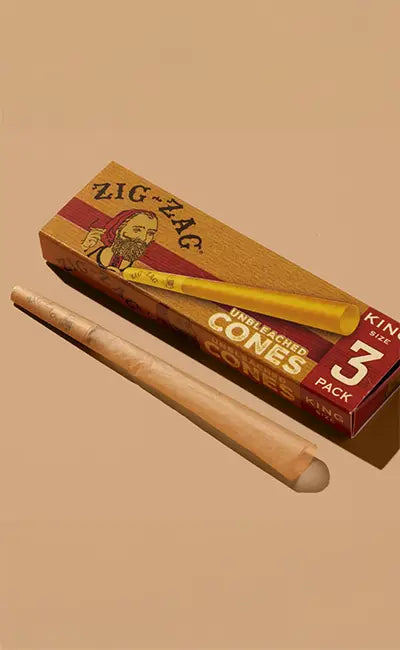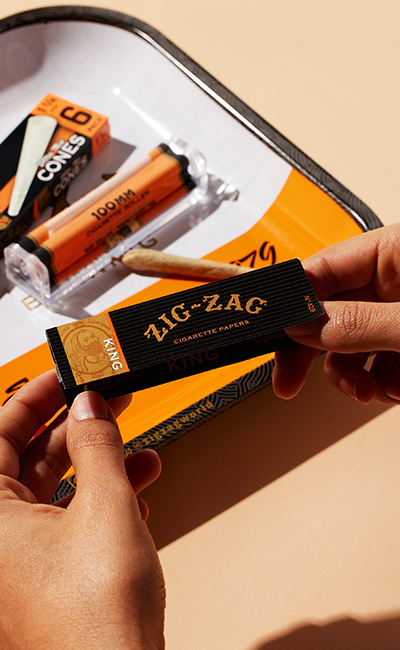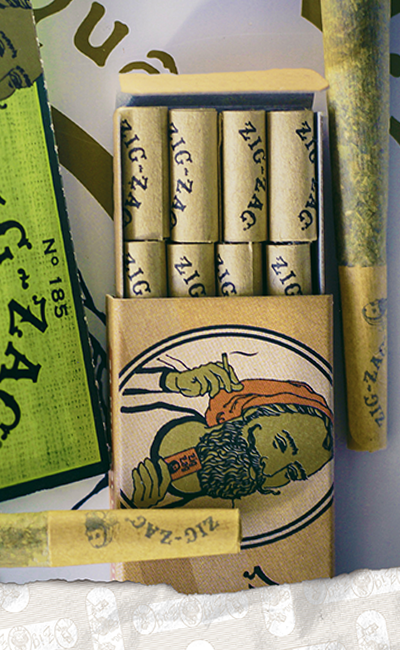Rolling your own cigarettes has become a popular choice for many smokers due to its cost-effectiveness and the personal satisfaction it provides. This method allows individuals to tailor their smoking experience to their specific tastes and preferences. Whether you prefer a stronger or milder blend, rolling your cigarettes allows you to adjust the tobacco density and flavor. This personal touch is something that pre-manufactured cigarettes cannot offer, making the rolling process not just a necessity but a craft many take pride in.
Understanding Cigarette Rollers
How Does It Work?
A cigarette roller is a small, typically handheld device designed to assist in rolling tobacco into paper. It consists of a base, rollers, and sometimes a lever, which creates a pocket to hold the tobacco while the paper wraps around it smoothly. By spreading the tobacco on the device and adding a rolling paper, the user can close the roller and either turn a wheel or slide a mechanism. This action rolls the contents into a neatly packed cigarette. Such devices are ideal for those seeking a uniform shape and size in their homemade cigarettes, providing a professional appearance and feel.
Types of Rollers
When selecting a
cigarette rolling machine, users can choose between these two. Compact rollers are portable, easy to use, and typically more affordable, making them suitable for personal use. In contrast, joint roller machines may offer features like adjustable settings for different sizes and tighter packs, catering to more advanced users or those who wish to experiment with various styles and thicknesses of cigarettes.
Key Benefits of Using a Roller
The main advantages of using one include increased speed and consistency. This method drastically reduces the time it takes to prepare a cigarette compared to hand rolling. It also eliminates the common problem of unevenly packed or misshapen rolls. For smokers who appreciate precision and uniformity, a roller is invaluable. It minimizes the wastage of tobacco and rolling paper, making it a cost-effective tool.
Materials for Cigarette Rolling
Due to their sustainability and natural properties, hemp papers have gained popularity among environmentally conscious smokers. Made from hemp fibers, these papers burn slower and more evenly than traditional rice or wood pulp papers, offering a smoother smoking experience. They are also less processed, which means they contain fewer chemicals, aligning with a greener lifestyle. Choosing
hemp papers can enhance the taste of your tobacco or herbal blend, providing a clean, pure drag every time.
Filters and Tips for Enhanced Smoking
Adding a filter or tip to your cigarette can significantly improve the quality of your smoke. Filters help reduce the inhalation of tar and other harmful substances, making the experience healthier and more enjoyable. They also provide a stable structure to your roll, preventing tobacco from entering your mouth. Tips, often made from ceramic or glass, can cool down the smoke before it reaches your lips, enhancing the overall smoothness of each drag.
Rolling Accessories to Perfect Your Setup
The right accessories can significantly enhance the rolling process, ensuring better quality, efficiency, and enjoyment. Whether you're a beginner or an experienced roller, investing in these tools can elevate your overall experience. Here's a breakdown:
-
Rolling Tray: This accessory is beneficial for capturing loose tobacco or herbs that might otherwise scatter. Rolling trays often come in various sizes and designs, allowing you to choose one that suits your style and needs. Some trays include compartments for filters, rolling papers, and small tools, further improving organization. Using a tray not only ensures a clean workspace but also streamlines the process, making it easier to roll efficiently and with precision. Having a dedicated space for rolling promotes cleanliness, reducing the risk of contaminating your materials with unwanted debris.
-
Storage Containers: Airtight containers help preserve the flavor and moisture of your tobacco or herbal blends, preventing them from drying out or becoming stale. Some storage solutions are designed for rolling accessories, offering compartments for papers, filters, and tools. Compact and durable containers also allow for easy transport, ensuring that your supplies remain protected when you're on the go. High-quality storage solutions not only extend the shelf life of your materials but also keep them neatly organized and readily accessible whenever you need them.
-
Packing Tools: These small devices evenly compress the tobacco or herbs within your roll, ensuring a uniform burn. Unevenly packed rolls can lead to irregular burning or waste materials, which packing tools effectively prevent. Available in various shapes and sizes, these tools are versatile and easy to use, catering to different rolling preferences. Incorporating packing tools into your setup ensures that each roll is consistent in density, resulting in a smoother and more satisfying experience every time.
-
Grinders: Evenly ground herbs not only make the rolling process easier but also contribute to a more even burn. Grinders come in various designs, from manual to electric, and often feature compartments to collect finer particles for later use. A high-quality grinder saves time and effort compared to breaking down herbs by hand while also minimizing waste. By investing in a grinder, you can achieve a higher level of precision and efficiency, enhancing the overall quality of your rolls.
-
Hygrometer: Overlying dry materials can result in brittle rolls and harsh burns, while overly moist tobacco may not burn effectively. Hygrometers provide accurate readings, allowing you to adjust storage conditions to preserve the optimal moisture content. Compact and easy to use, these tools are especially valuable for enthusiasts who want to ensure consistency and quality in their rolls.
Incorporating these accessories into your rolling setup not only simplifies the process but also enhances the quality of your rolls. Each tool plays a specific role, from maintaining freshness to ensuring uniformity, contributing to a more enjoyable and efficient experience. By investing in the right accessories, you can transform rolling into a precise and satisfying ritual.
How to Use a Rolling Machine
Preparing Your Materials
Before you start rolling, it's essential to ensure that all your materials are ready. This preparation includes grinding your tobacco or herbs to the right consistency—not too fine, as it can cause uneven burning, and not too coarse, as it might hinder the rolling process. Also, have your
hemp rolling papers and filters within easy reach. A well-prepared rolling station will streamline the process and result in better-rolled cigarettes.
Loading the Roller Correctly
Start by opening the roller and evenly distributing your tobacco along the width of the roller. Avoid overfilling as it can make the machine difficult to close and might result in a poorly rolled cigarette. Place the filter at one end if you use one, then carefully lay the rolling paper with the adhesive strip facing you and on top. This positioning ensures that it will seal properly after the roll.
Rolling and Sealing the Perfect Cigarette
Each step plays a pivotal role in ensuring the cigarette is tightly packed, evenly rolled, and aesthetically pleasing. Following a systematic approach not only improves the quality of the roll but also enhances the overall smoking experience. Here is a guide to each step, helping you master this process:
-
Close the Roller: The first step in the rolling process is gently closing the two halves of the roller. This action traps the paper and its contents, securing them in place for the next step. Closing the roller should be done carefully to ensure the paper remains centered and the tobacco or herbal blend doesn’t spill out. Proper alignment is essential, as even a slight misplacement can lead to uneven rolling. This step acts as the foundation for the rest of the process, creating the structure needed to roll a cigarette that is uniform and stable. Taking your time to ensure the roller is properly closed will save you from potential issues later in the process.
-
Roll the Base: Use your thumbs and forefingers to roll the base rollers toward you in a steady motion. This action helps tuck the bottom of the rolling paper around the tobacco and filter, creating a snug fit. Rolling too loosely can result in a cigarette that burns unevenly while rolling too tightly can restrict airflow. Finding the right balance takes practice but is essential for achieving a smooth burn.
-
Lick the Gum: Lightly moistening the adhesive strip on the rolling paper is vital for sealing the cigarette. This can be done with your tongue or a damp sponge, depending on your preference. Using just the right amount of moisture is key—too much can weaken the adhesive and cause the paper to tear, while too little may result in the seal failing to hold. The gum should feel slightly tacky when moistened, allowing it to bond securely when pressed.
-
Complete the Roll: After moistening the adhesive, turn the rollers again to pull the paper into the machine. This action wraps the paper tightly around the tobacco and filter, forming the final shape of the cigarette. The moisture from the gum creates a secure seal as the paper adheres to itself. Proper technique in this step ensures the cigarette is compact, which is essential for a consistent and smooth burn. Take care to roll steadily and evenly, as rushing this step can lead to wrinkles or gaps in the paper. Completing the roll properly guarantees the cigarette is well-constructed and ready for use.
-
Open and Reveal: The final step is to carefully open the roller and unveil your perfectly formed cigarette. This is the moment where all your efforts come together, resulting in a tightly packed and neatly rolled product. Take a moment to inspect the cigarette for any imperfections, such as loose ends or uneven packing. Adjustments can be made if necessary, but a well-executed roll should require little to no additional work. Opening the roller with care ensures the cigarette remains intact, preserving its structure and appearance.
Mastering the art of rolling and sealing cigarettes takes practice, but each step is designed to build upon the last, culminating in a high-quality roll. This process not only elevates your rolling skills but also enhances your smoking experience, making each cigarette a product of precision and care.
Rolling vs. Pre-Rolled Cones
Advantages of Using Pre-Rolled Cones for Smoking
These offer a convenient and user-friendly alternative to traditional rolling. They eliminate the need for mastering the rolling technique by hand, providing a ready-to-pack option that ensures consistency in size and shape. Convenience particularly appeals to novice rollers or those who value time savings. It is also available in various sizes and materials, including
organic pre-rolled cones, which cater to those seeking a natural smoking experience without the hassle of rolling.
Smoking Cones with Filters
This feature is essential for smokers who prioritize their health but prefer the full flavor and custom fill of rolling their cigarettes. The filters also stabilize the structure of the cones, preventing collapse and ensuring a smooth draw with each puff.
Maintenance Tips for Long-Lasting Tools
Clean Regularly
Over time, residue from tobacco, herbal blends, or adhesives can accumulate on the rollers, trays, or other components, reducing efficiency and potential malfunctions. To clean your cigarette rolling tools, use a soft brush or lint-free cloth to gently wipe away any debris. For more stubborn residue, consider using a mild cleaning solution or isopropyl alcohol, but ensure the tools are thoroughly dried before use. Cleaning not only improves the performance of your equipment but also helps maintain hygiene, an often overlooked aspect of tool maintenance. Dedicate a few minutes after each use to this task for optimal results.
Disassemble Carefully
Carefully taking apart the roller allows you to access internal mechanisms where residue often accumulates. Handle the disassembled parts gently to avoid damage, particularly with delicate components like rollers or gears. Use small brushes or compressed air to clean hard-to-reach areas effectively. Reassembling the tool correctly is equally important—follow the manufacturer’s instructions to avoid misalignments or loose fittings. Regular disassembly and cleaning keep the tool’s mechanisms running smoothly, preventing jamming or uneven rolling.
Store Properly
Moisture is one of the biggest threats, as it can lead to rust or warping in metal and plastic components. Heat and direct sunlight can weaken materials over time, compromising the tool’s integrity. Store your equipment in a cool, dry place, such as a drawer, cabinet, or dedicated storage box, to safeguard it from these elements. If you travel with your tools, use protective cases to prevent damage during transit. Proper storage not only extends the life of your tools but also ensures they remain in excellent working condition whenever you need them. This simple habit can save you from unnecessary repairs or replacements.

Selecting the right tools for your smoking routine is essential to ensure satisfaction and efficiency. Whether it’s deciding between a compact cigarette roller for on-the-go smoking or investing in high-quality
rolling accessories to enhance your setup at home, the choices you make should reflect your personal smoking habits and aesthetic preferences. Each component, from the type of paper to the style of roller, contributes to the overall quality and enjoyment of your smoking experience. By carefully following these cigarette rolling tips, you can elevate your technique and enjoy consistently well-crafted cigarettes or joints.



















